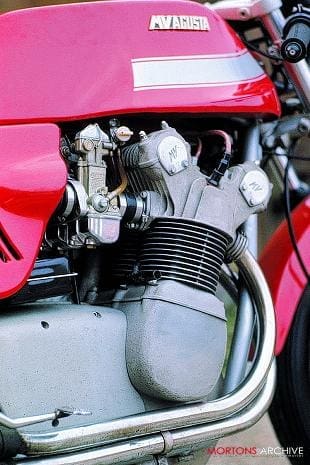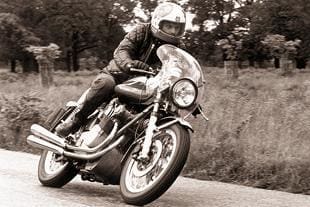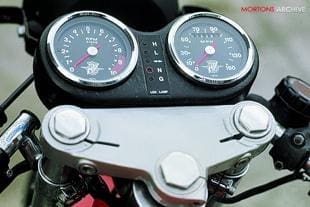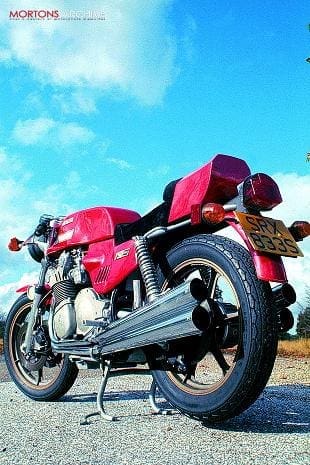Between 1966 and 1972, Italian star Giacomo Agostini won the 500cc world championship as he pleased, with no significant opposition. The MV Agustas he campaigned were nothing like the modern versions produced by the Cagiva group: they were pure-bred racers that had been developed over two decades and had acquired a reputation as exclusive, exotic, multi-cylinder machines that few people had access to.
True, MV’s seven-year winning streak, complemented by Ago’s five 350cc titles from 1968 to 1972, resulted mostly from the other Italian factories pulling out of racing in 1967. As an opportunity for MV Agusta to sell road bikes on the back of racing success it was as good as it gets.
But it wasn’t until 1969 that the Gallarate factory launched a sports bike, the 750S, and even then production versions were only available in small numbers after 1971. Today, the top motorcycle manufacturers develop road bikes alongside MotoGP and Superbike racing machines, squeezing every last drop of publicity from marketing campaigns.
 Why MV’s aristocratic family owners never made the decision to make their road bikes in bigger volumes we’ll never know. But because MV Agusta road bikes were so rare and unattainable, they were that much more desirable. Few riders knew what they were like, and the racing image was further enhanced.
Why MV’s aristocratic family owners never made the decision to make their road bikes in bigger volumes we’ll never know. But because MV Agusta road bikes were so rare and unattainable, they were that much more desirable. Few riders knew what they were like, and the racing image was further enhanced.
So in 1973 when Chris Meek, then owner of the Mallory Park racing circuit, called the office of Motor Cycle with an offer to road test his MV Agusta 750S, I nearly bit his hand off, so to speak.
Meek filled the image of the archetypal MV owner: rich, flamboyant and keen for a bit of publicity. He’d spent upwards of £2000 on a motorcycle – much more than twice what you’d expect to pay for a top-of-the-range Kawasaki 900 – and as a businessman he no doubt wanted to get his money’s worth out of it.
I was happy to oblige. With barely a year of road testing for the paper under my belt it was a chance not to be missed. And so started my relationship with a number of MV Agustas that plumbed the depths of frustration as much as climbing the heights of exultation.
The 750S was a beautiful machine in every way. With a red-painted frame and supple red racing seat, huge blue-and-white fuel tank, lashings of polished aluminium and that iconic double-knocker four cylinder engine taking centre stage it was a feast for the eye.
It sounded as if it came straight from the race track too, its four chromed exhaust pipes blasting out a symphonic chime that barely overwhelmed the mechanical chattering of the engine. To see and hear it was to be hooked.
Slim for a four, the 750S offered a well-balanced riding position with wonderfully smooth controls that showed care had been taken in their design. Clip-on handlebars had soft grips and sculpted levers. The alloy knurled footrests were set well back – unusual for the day – with short foot levers. Brakes were huge drums, the front using four leading shoes. First impressions were a delight.
MV Agusta first revealed the pro totype of a four-cylinder road bike as far back as 1950. It was both stylish and novel with a parallelogram arrangement for the rear suspension and twin round headlamps. It looked very similar to Gilera’s pre-war supercharged racers because the design came from the pen of the same engineer, Reno Leoni.
totype of a four-cylinder road bike as far back as 1950. It was both stylish and novel with a parallelogram arrangement for the rear suspension and twin round headlamps. It looked very similar to Gilera’s pre-war supercharged racers because the design came from the pen of the same engineer, Reno Leoni.
But it was never commercialised. It took another 15 years before MV sprung the first modern four, the portly 600 tourer with dual front cable-operated discs and shaft drive. Few were sold, and the first thing most buyers wanted to do was convert it into a sportster.
The 750S was a derivative of the 600 using a similar but overbored engine. Peak power of the 743cc (65 x 56mm) engine was 65 bhp at 7900 rpm: this was enough, said the factory, for an top speed of 129 mph. The most novel feature of the motor was that it used a single casting to house the crankshaft and gearbox.
Like the racing engines the crankshaft was a built-up assembly running in roller bearings. Likewise the one-piece connecting rods ran on needle rollers. The crank assembly was then assembled into another casting that dropped into the top of the crankcase. Onto this, individual cylinder barrels were mounted to be topped by a one-piece cylinder head.
 Between the two middle cylinders a train of spur gears (carried in another casting) took the drive to the twin overhead camshafts. The valves, operating at what was then a typically wide 90-deg included angle, were opened by cam lobes that operated on inverted buckets.
Between the two middle cylinders a train of spur gears (carried in another casting) took the drive to the twin overhead camshafts. The valves, operating at what was then a typically wide 90-deg included angle, were opened by cam lobes that operated on inverted buckets.
As with most of the engine, the valve clearance adjustment required careful stripping, measurement and reassembly for the best results. ‘Lash’ in the primary gear drive depended on the assembly of the crankshaft into the cases, which contained separate drives for the oil pump in the sump and the ignition distributor on the top of the gearbox. It was hardly ideal for mass production.
The most obvious clue to the engine’s racing heritage was that the combined generator and starter motor were mounted beneath the five-speed gearbox and connected to the engine through v-belts.
Yet while the sound and style of the 750S screamed of MV’s sporting background, it anachronistically retained the 600’s shaft drive. Now, had the original 750S been the blistering sports machine we’d expected, that might have been a disadvantage. As it turned out, it was more of a damp squib.
Once you got over the initial euphoria of riding a machine from the most successful racing stable in the world, Meek’s 750S was not much faster than a big British twin of the day and certainly less quick off the mark, partly due to an all-up weight of more than 500 pounds.
I was always cautious about performance testing machines supplied by owners at MIRA’s proving ground. But Meek was happy for me to take the 750S to the limit. In this case it was easy.
In America, a 750S had been tested at 114 mph with a quarter mile time of 14.5 seconds, well below the claims from the factory. Meek’s bike, even taking into account that we took average speeds to counteract the influence of prevailing winds, was much slower.
The best I could wring from the bike was a mean top speed of 112.34 mph with a best one-way speed of 120.84 mph. The standing quarter mile time would have been better measured with an hour-glass: 15.9 seconds with a terminal of 89 mph was in the same league as 350s. I handed the bike back to Meek with my thanks and wondered what all the fuss had been about.
As it turned out, the 750S was in a very mild state of tune as supplied by the factory, and Meek’s less than its best. Gallarate must have been aware of the impact that such poor performance would have on the bike’s sales and produced an updated version for the end of 1973.
 Both the engine and brakes were improved and had a dramatic effect on the performance. Pistons providing a higher 10 to 1 compression ratio, camshafts that increased peak valve lift from 8.0 to 8.5mm, a inlet valve diameter increased from 30mm to 31.8mm and Dell’Orto VHB carburettors with square slides and 27mm rather than 24mm bore.
Both the engine and brakes were improved and had a dramatic effect on the performance. Pistons providing a higher 10 to 1 compression ratio, camshafts that increased peak valve lift from 8.0 to 8.5mm, a inlet valve diameter increased from 30mm to 31.8mm and Dell’Orto VHB carburettors with square slides and 27mm rather than 24mm bore.
All this had the combined effect of raising the peak power to 69 bhp at 8500 rpm. Other changes in the engine were to the clutch gear which made disassembly easier, and some minor alterations to the castings.
The test machine provided in June of 1974 this time came from the UK importer, south London dealer Gus Kuhn Motors, and its performance belied the additional four bhp that the factory claimed for it.
The 750S had been turned into a genuine 120 mph machine with top end acceleration to match. Its weight of about 510 pounds still conspired against it because of its close gearbox ratios that gave speeds at 8500 rpm of 55, 77, 103, 118 and 130 mph. With the high bottom gear, acceleration off the mark was poor, but once it got going the bike was the joy to ride that it should have been.
Through the quarter mile the 750S clocked a mean 14.15 seconds (Bonneville territory) with a terminal speed of 101.17 mph (best in class). Its mean top speed of 122.68 mph was far swifter than Honda’s CB750 of the time and would not be bettered by a 750 until Suzuki’s GS750 arrived two years later.
Better braking was provided by a pair of front discs using opposed-piston calipers supplied by Italian manufacturer Scarab. With the higher speeds attainable these were more than welcome.
The MV Agusta 750 had been turned into the class act that everyone had believed it was.
But it wasn’t enough for the American market, where the importers Chris Garville and Jim Cotherman of Commerce Overseas knew that improvements would make the MV Agusta more appealing to US tastes. Their views found a willing recipient at the factory in the form of Fredmano Spairani, who had moved from the Ducati factory at Bologna. The result was the 750S America that appeared during 1975. It was a machine that offered a new style and, hopefully, more speed.
For style, the fuel tank and seat used a more sculpted design that owed much more to the racers of the early Seventies, along with improved switch gear. The Ceriani telescopic front fork’s legs used a larger diameter 38mm to tauten up the handling. For speed, power was increased by upping the engine’s capacity to 789cc with an increase in the cylinder bore to 67mm. Otherwise, the camshafts were the same 8.5mm lift items from the 743cc engine, but the compression ratio was lowered to that of the original 750S.
Peculiarly, the carburettor bores were reduced in size from 27mm to 26mm, but this was partly because of the availability of Dell’Orto units that were supplied en bloc with enclosed lifters which stayed in tune more reliably.
To comply with increasingly stringent noise laws in the US, a modern air intake box was provided, along with ugly new heavy silencers that were black-finished. But the power was upped to a claimed 75 bhp at the crank with peak torque of 48lb-ft at 7500 rpm.
By now, a new impor ter had been established for the UK. Agusta Concessionaires realised that the US models might release even more performance if factory-supplied silencers, fairings and special cast-alloy wheels were offered. I tested the 750S America in a number of forms at MIRA early in 1977 but although quicker through the quarter mile none were better all round than the 750S.
ter had been established for the UK. Agusta Concessionaires realised that the US models might release even more performance if factory-supplied silencers, fairings and special cast-alloy wheels were offered. I tested the 750S America in a number of forms at MIRA early in 1977 but although quicker through the quarter mile none were better all round than the 750S.
Mean top speeds of the two 750S Americas tested on the 1000-yard test strip were 120.24 mph and 119.76 mph respectively. Acceleration through the quarter mile of the first bike, NRX 40R, was quicker at 13.8 seconds (a result of better torque from the capacity hike) but tellingly, the terminal speed was slower at 100.2 mph. I suspect this might have more to do with Gus Kuhn’s tuning skills with the earlier machine.
Undismayed by this, and faced with continuing financial uncertainty at the factory during 1977 (compounded by its withdrawal from racing at the end of the previous season), another even more potent machine was produced by Gallarate.
This was the Monza with an additional increase in capacity to 813cc (bore size now 68mm) and, more importantly, the use of a twin-point Bosch ignition system rather than the old single point system with a distributor. Also significant in releasing more power was a revised camshaft profile and the reversion to the 27mm Dell’Orto VHB carburettors which, although requiring more frequent maintenance to keep in tune, matched the inlet ports correctly. The combined effects of these changes lifted the power dramatically to 85 bhp at 8750 rpm.
But it was probably too much for the transmission. As we found out at MIRA during a windy October day in 1977, the bike was fearfully fast. Motor Cycle staffman Stewart Boroughs clocked a best top speed of 135. 69 mph with a strong tail wind but in the opposite direction the best he could manage was 124.79 mph in fourth gear.
That gave a mean of 130.24 mph which was pretty good, but we suspected that the gearing was too high for the peaky power delivery. This was backed up by the top speeds taken with the rider in a ‘normal’ stance, rather than flat on the tank. The mean worked out at 121.84 mph in fourth gear.
 So just out of curiosity, Stew took the bike to the adjacent mile-long straights that were linked by curves that could be taken at about 70 mph. Stew had a faster entry speed to the straights and longer to build up speed, and it worked. With the tail wind the Monza clocked 144 mph one-way, measured with a hand-help radar gun, and 136 mph in the opposite direction. The mean was 140 mph, just what we’d hoped a really fast Italian sports bike should be capable of.
So just out of curiosity, Stew took the bike to the adjacent mile-long straights that were linked by curves that could be taken at about 70 mph. Stew had a faster entry speed to the straights and longer to build up speed, and it worked. With the tail wind the Monza clocked 144 mph one-way, measured with a hand-help radar gun, and 136 mph in the opposite direction. The mean was 140 mph, just what we’d hoped a really fast Italian sports bike should be capable of.
Just how quick the Monza was through the quarter mile I can’t say. The test data goes strangely blank after three runs that showed terminal speeds of around 104 mph. Either the timing gear failed or the Monza’s clutch failed.
But the Monza was clearly the fastest road MV to be made by the factory. And the last. Early in 1978 production of motorcycles ceased, and although a number of machines were subsequently assembled in the UK from parts, there would be no more MV Agustas made at Gallarate.
It was an ignominious end to a glorious chapter in motorcycle history. Derivatives of the MV fours would be developed by specialists such as Arturo Magni, in capacities up to 1200cc, and the echoes of MV racers would live on in the hands of a number of classic racing teams. Whether the Monza was the best MV is debatable. My favourite is the earlier 750S, which was both fast and furious.



